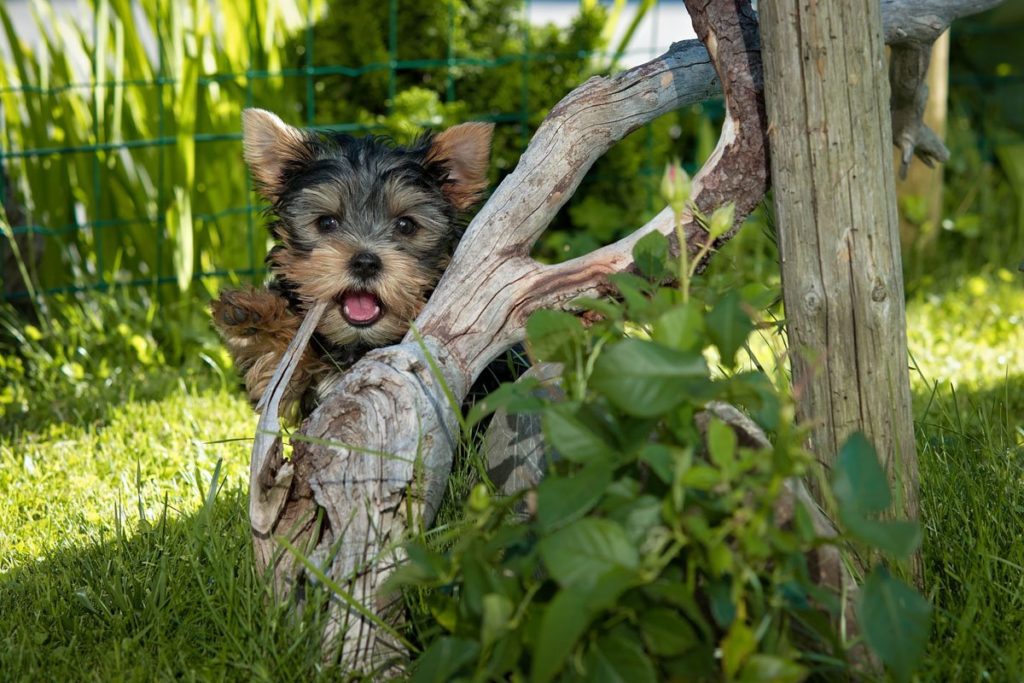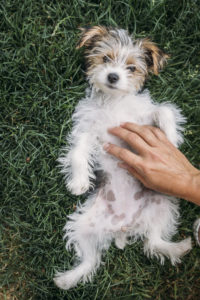You walk through the mall and hear cheerful yipping coming from the pet store. There’s a crop of puppies wrestling in the front window. It’s impossible to resist smiling at their antics, and you feel tempted to bring one home. Or maybe you’re scrolling through Facebook and see an ad in the Marketplace for litters of your favorite breed. There’s even a photo of the sweetest little face, encouraging you to click on the link. Perhaps you’re strolling through a local flea market and wander past a pen of puppies sitting under a “For Sale” sign. What do these have in common? They support puppy mills. And they need to be avoided at all costs.
Puppy Mills
What is a puppy mill? A puppy-production factory focused on making the owner as much money as humanly possible – while spending as little money as humanly possible. That translates to poor living conditions, minimal (if any) veterinary care, and breeding practices that defy reason. And, unfortunately, puppy mills are legal in most states. The USDA is tasked with regulating such facilities, but out of the estimated 10,000 that exist, only 2,000 have official approval. Why such a difference? And how did so many GET approval? Welcome to the Animal Welfare Act (AWA).
“A large scale commercial dog-breeding operation where profit is given priority over the well-being of the dogs.”
~ASPCA Definition of a Puppy Mill
The AWA regulates animal activities on the federal level, including dog breeding. Sounds fantastic, right? Unfortunately, the AWA’s standards of care only define enough to allow a dog to survive. The definition falls short of what most decent people feel an animal requires, allowing puppy mills to get away with shoddy practices. Throw in the fact that the USDA doesn’t have enough inspectors to get around to all 10,000 facilities, and the puppy mill industry continues to thrive. The nasty cycle starts to feel unbreakable – especially if people don’t understand what happens behind those pretty websites or pet store doors.
Used and Abused – Adult Dogs in Puppy Mills
You can’t make a profit if you don’t have puppies to sell. The adult dogs at puppy mills end up bred repeatedly, with no rest period between litters. And the breeding starts as early as possible. The result is a female dog whose body is depleted of resources within a couple of years. She ends up exhausted and may suffer from eclampsia as calcium levels in her body drop dangerously low. When she’s no longer able to carry puppies, she suffers one of two possible fates:
- Abandonment
- Euthanasia
While “working,” the adults find themselves housed in uncomfortable wire cages that lack padding on the bottoms. Their feet protrude through the wires, developing sores and wounds – wounds that rarely receive treatment. Odds are (especially for the males) no shelter covers the top, leaving them exposed to rain, snow, and extreme heat. If kept indoors, there’s no ventilation. Cages rarely get cleaned, leaving the animals to sit, stand, and lay in their waste. No one bathes them, pets them, loves them.
Profit Puppies – Young Dogs in Puppy Mills
Approximately 2.11 MILLION puppies from puppy mills find their way into people’s homes every year. Trying to imagine the amount of money attached to that number is staggering – and heartbreaking. Because those puppies don’t enjoy any happier a life than their parents.
By 6-8 weeks of age, they find themselves separated from their mothers – MUCH too young. (After all, the mother’s needed to produce another litter) Multiple litters find themselves squeezed into too-small kennels, fighting for space and food. They’re the same wire cages the adults struggle with, but puppy paws are softer – more prone to swelling, bleeding, and infection. Food and water quickly end up contaminated. (Puppies and parasites – it’s a common combination) Malnutrition sets in. There’s no room to run or play. And socialization – that important part of a puppy’s growth? Forget it. The puppies go days and even weeks without SEEING a human being.
To say nothing of the possibility of undetected genetic issues lying in wait under the surface. Puppy mill owners aren’t careful with their breeding, and defects run rampant. Diseases and disorders bubble under the surface, waiting to surprise the puppy’s new owner:
- Bladder issues
- Blood disorders
- Distemper (NO cure!)
- Ear issues
- Endocrine disease
- Epilepsy
- Eye issues
- Kidney disease
- Parvovirus
- Respiratory problems
- Skin conditions

Understanding the Root of the Problem
Knowing such horrors, how are puppy mills thriving? The USDA (and ASPCA and Humane Society) are doing the best they can, but it’s the CONSUMER that drives the industry. The frantic demand for new “designer” breeds (such as Labradoodles, Cockapoos, and Puggles) and specialized sizes (such as tiny and teacups) make puppy mill owners so successful. These breeds aren’t registered with AKC Breed Clubs, opening the door to unethical breeding practices.
For other popular dogs (Pugs, particularly), long waiting lists with registered breeders prompt people to look for alternative sources. Why sit for six months while a mother dog is allowed to rest and recover, spend time with her puppies, and properly wean them when you can have your puppy NOW?
Not to mention that reputable breeders charge higher prices. The charge covers the veterinary care, socialization, high-quality food, and care the puppy receives up to the point you bring it home (they often live in the house – not in deplorable cages in a warehouse). A lower bargain price sounds SO much better. It’s exploitation that puppy mills jump on. People don’t understand the industry they’re supporting. They only see an adorable face – and immediate availability at a lower cost.
Of course, if you aren’t caring for a puppy, you can charge a lot less – can’t you?
Fixing the Problem
It’s tempting to hope the USDA will catch up with puppy mills. Or that the AWA will get amended and increase the standards of care. And perhaps those things WILL happen – eventually. If you want to help put an end to puppy mills, though, it starts with YOU.
If you stop supporting the industry, it’ll collapse. After all, puppy mills are money-making endeavors. Without money coming in, they stop existing. And while it’s tempting to justify bringing one of those puppies home to “save” it – you’re not. Buying a puppy continues to support these people.
What you CAN do is report the person (or pet store!) to the authorities. They’ll open an investigation and shut the puppy mill down. They’ll also seize the animals, getting them the proper veterinary care they’ve been denied. If you want, keep tabs with the investigation team, and you’ll likely have an opportunity to adopt the puppy down the road – with a clean bill of health. (A MUCH better idea for you – and your bank account!)

Recognizing Puppy Mills
If you aren’t sure if you’ve stumbled onto a puppy mill puppy, take a look at the source carefully. There are ALWAYS red flags that will trigger your gut instinct. If you notice any of these, walk away AND alert the authorities. You’ll be doing everyone a favor – especially the poor, suffering dogs.
Festivals, Flea Markets, and Roadsides
Reputable breeders don’t set up pop-up tents and wire pens on the weekends. You have to go to them, meet on their terms, and see where the puppies have grown up – where the mother lives. When you visit flea markets, there’s no doubt those puppies tumbling over one another look cute, and you better believe they’re active. This is the first time they’ve had room to MOVE! They might be touching grass for the first time. And that clean air? It’s ambrosia! You see a lie. Puppy mill owners set up stands to reel you in – MILES away from the actual warehouse.
Online Classifieds
No one with a stellar reputation puts an ad on Craigslist or Facebook (or the newspaper – if you read print). Breeders affiliated with AKC Breed Clubs create professional websites (and don’t worry – we’ll get to website scams in a second). And when you see words such as “always available” or “immediately available,” run screaming to the authorities. Remember, puppy mills breed constantly, so they have puppies throughout the year. That’s a HUGE red flag. (Also, why are you looking at the classifieds? If you’re interested in a puppy that bad, hit up your local rescue or shelter. I promise they’re stocked)
Pet Stores
While 2,000 pet stores have stepped up and signed the Humane Society’s Puppy-Friendly Pledge, there are still plenty of other pet stores out there that stock puppies in the window. Reputable breeders do NOT sell to pet stores. It’s honestly that simple. If you see a dog (or cat) in a pet store and a rescue group does not sponsor it, then they’re from a puppy mill. Even if the store owner says differently, the “broker” or middle man who provided the puppies got them from a puppy mill.
“The fact is, responsible breeders would never sell a puppy through a pet store because they want to screen potential buyers to ensure that the puppies are going to good homes.”
~ASPCA
Websites
Here’s where it gets tricky. Because if you’re willing to spend a little money, you can find someone who’ll create a half-decent website for you, and some puppy mills do just that. How to tell the reputable breeders from the puppy mills? Obviously, they’re not going to post pictures of their deplorable warehouses. They’re going to use stock photos of adorable puppies to sucker you in. And they ALWAYS present falsified information for the puppy’s health and genealogy (it isn’t difficult to create). Luckily, they still trip themselves up. Here’s what to watch for:
- They offer MULTIPLE breeds, especially “designer” breeds
- Reputable breeders focus on a single breed, so they meet the standards
- Puppies are six-weeks-old (or younger)
- You are NOT allowed to see the entire premises (if you get to visit at all)
- They may be out of state and tell you they need to ship the puppy
- They refuse to show you where the puppies and mother are kept
- The breeder doesn’t ask YOU any questions
- Reputable breeders should grill you on your experience with the breed, your family’s lifestyle, your plans for the puppy
- There’s no written guarantee
- Reputable breeders agree to accept a dog back at ANY time for ANY reason
- You don’t get a vaccine record or the name of the vet
- Always contact the name of people you DO receive
- They pressure you to purchase
Adopt, DON’T Shop!
Puppies tug at our heartstrings. We see them, and there’s an immediate desire to bring one home. But if you don’t consider WHERE that puppy’s coming from, you may be supporting the puppy mill industry. Adopting a puppy from a rescue or shelter is the best way to prevent this from happening. You can find rescues for every breed you can think of – the result of this horrible industry, actually. If you believe strongly that puppy mills need to end, consider stepping up and signing the ASPCA’s pledge NOT to purchase a puppy mill puppy. You have no idea how many lives you’ll end up saving.
The more we support adoption and rescues, the better our odds of crushing the puppy mill industry. Everyone just needs to do their part!













No comment yet, add your voice below!